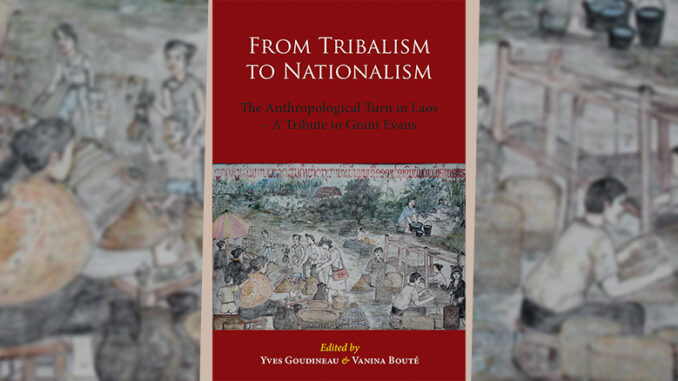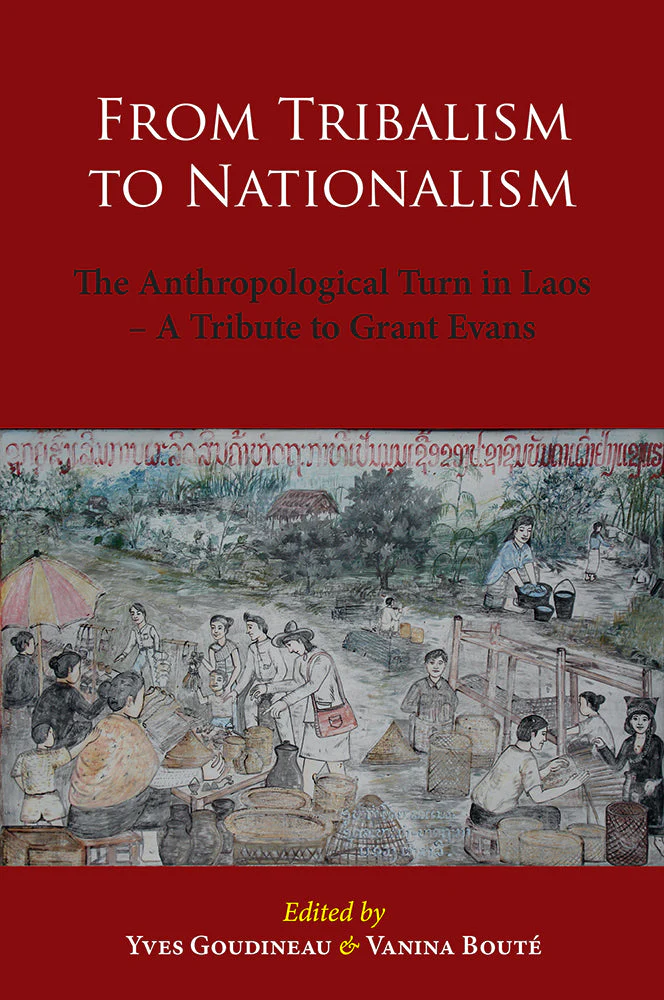
Title: From Tribalism to Nationalism: The Anthropological Turn in Laos – A Tribute to Grant Evans
Authors: Yves Goudineau and Vanina Bouté (Eds.)
Publisher: NIAS Press, 2022
The late Grant Evans’ contribution to the anthropological study of Laos is beyond dispute. That From Tribalism to Nationalism: The Anthropological Turn in Laos – A Tribute to Grant Evans joins the ranks of two previous special issues in the Journal of Lao Studies and The Australian Journal of Anthropology in honoring Grant Evans attests to his outstanding role as an excellent and highly esteemed scholar, significantly shaping the field of “Lao Studies” and anthropology of (mainland) Southeast Asia in general. This volume, carefully edited by Yves Goudineau and Vanina Bouté, foregrounds the crucial role of ethnographic fieldwork in critically examining notions of ethnicity in the context of ideological projects of nationalism. In this regard, Yves Goudineau considers in his introduction chapter Grant Evans as “the first researcher to be able to carry out real field studies” (p. 4). Doing so already in the 1980s, and thus before Laos’ gradual opening-up to international researchers in the 1990s, he initiated the “anthropological turn” (pp. 11-16) in studying Laos, critically going beyond previous limited ethnographic endeavors of merely surveying ‘ethnic minorities’ which ultimately has served different political projects of colonialism, post-independent nationalism, and socialism. It is this historical continuity of “tribalisation” (with “tribalism” in the book title not really being explained though) that is said to constitute the overall guiding topic of this volume, centrally understood in a dialectical relationship with nationalism, “where state control of ethnicity also aims to impose limits on multiculturalism” (p. 9).
However, while carefully reading all excellent twelve chapters, it stands out that mainly the contributions by Yves Goudineau tackle this issue directly. He revisits the political/ideological utilization of ethnicity, outlined in the introduction, in his concluding chapter, which he dedicates to Grant Evans’ call for an anthropology more sensitive to the complexities of ethnic identity. Examining the historical emergence of the ethnic label “Katu” in the southern periphery of Laos (Upper Sekong region), Goudineau takes issue with the “anthropology of Southern Laos” in general, which he sees still being caught in representations primarily deriving from colonial discourses on civilization, racialized otherness and essentialized cultural tradition. He demonstrates that the largely external identification of the Katu has been based on the lack of actual knowledge and merely understood in relation (or opposition) to other better known ethnic groups such as the Loven in the adjacent Boloven Plateau who were seen to be economically more developed due to closer contact to processes of “Lao-isation” (pp. 150-151). That “Lao-isation” has been “determinant in the creation of various ‘ethnic groups’” (p. 157), is still linked to the present context of the Lao state project to define, research and ‘invent’ ethnic groups as integral and compatible part of Laos, the nation of the Lao ethnic majority.
This brings us to the central question of how, or whether it is possible at all, to properly study issues of ethnicity in Laos without reifying the national project of ethnic groupism. Against this background, it is somehow striking that the notion of ethnic groups still shines prominently through several chapters, such as Ian G. Baird’s chapter on the specific socio-spatial organization and ethnic identities among the Brao in the borderlands of southern Laos and northeastern Cambodia, Vanina Bouté’s chapter focusing on specific rituals by the Phunoy in the northern Phongsaly province and Guido Sprenger’s chapter reflecting on the discontinuance of rituals among the Rmeet (Lamet) in the northern Luang Namtha province. Although Ian G. Baird importantly highlights the (albeit already well-studied) complex fluidity and flexibility of situationally shifting ethnic identities (pp. 175-179), the underlying notion of ethnic groups remains untouched. One central remedy, suggested in several chapters, to avoid essentializing rigid notions of ethnic identities is a focus on inter-ethnic relations—but again, mainly understood between ethnic groups. Provoking us to study “ethnicity without groups” (Brubaker 2004), Roger Brubaker argues that “[b]ounded and solidary groups are one important modality of ethnicity (and of social organization more generally), but they are only one modality” (Brubaker 2009: 30). In this regard, Olivier Évrard and Chiemsisouraj Chanthaphilith argue in their meticulously drafted chapter on different oral histories and myths of the foundation of Viang Phu Kha in present Luang Namtha province with the notion of a transethnic system, “that is, a context in which ethnolinguistic categories cannot constitute starting points for analysis […]” (p. 230).

My longer discussion centered on ethnicity here, reflecting the book’s title, should not turn attention away from other important anthropological impulses covered by this volume. Refreshingly going beyond the conceptual grid of ethnic groups, Boike Rehbein provides a Bourdieusian socio-linguistic analysis of how different “sociolects” of Lao language are applied within different social and cultural structures and practices, resulting in “sociocultures” formed within different periods of national political integration, linguistic standardization, social differentiation, simplification, potential Thai-ization and internationalization. It is with great sadness that Boike Rehbein passed away very suddenly, shortly before the publication of this book.
Another important impulse for future ethnographies in Laos is the chapter by late Grant Evans himself, in which he revisits his seminal works on the peasant economy. He laments the decline of economic anthropology in fully grasping the peasants, throughout history interlinked with regional trade networks, as a dynamic social formation. While he admits the probable demise of the peasantry in Laos, he still deems the historically grounded understanding of the peasantry imperative for examining further social and economic change in Laos. I would go one step further in calling for a serious study of the occupational diversification gradually involving more non-farm activities, which I undertook for the case of a newly emerging, ethnically and socially diverse, group of small-scale cross-border traders in northern Laos (Rowedder 2022). A focus on evolving occupational identities could contribute to more complete anthropological research of contemporary Laos, going beyond the old-established reference points of peasantry and ethnicity.
Change is thus the other main issue guiding this book—not so much in terms of analyzing new livelihoods and associated social formations, but of focusing on how processes of modernization have affected, and been creatively responded by, pre-existing traditional and cultural features, especially of religion and rituals. Patrice Ladwig’s historically informed chapter examines the shifting role of Buddhist monasteries in Vientiane. The gradual removal of its educational function with the advent of the socialist state is representative of functional differentiation leading to the simultaneous dissolution of old and demarcation of new bounded religious fields (again, as in Rehbein’s chapter, in a Bourdieusian sense). Deprived of their educational function, Buddhist monasteries became more ‘narrowly religious’ sites in a modern secular state embedded in (not paradoxical) trends of Buddhist revivalism. The chapters by Vanina Bouté and Guido Sprenger, both based in northern Laos, examine how external interventions of respectively orthodox Buddhism and state regulations led to creative configurations of spiritual cults and rituals among the Phunoy in Phongsaly province and the Rmeet (Lamet) in Luang Namtha province. In the latter case, the ostensible discontinuance of rituals is still often rooted in the flexible search for functional equivalents to make sense of change through the ritual system itself.
Not only culturally specific worlds of ‘past’ ritual practices are shaped by, and in turn flexibly adjust, to present dynamics of change, but also the official writing and often divergent local memories of the past. The excellent contributions of Vatthana Pholsena and Oliver Tappe demonstrate how official historiography is often based on mythologized pasts that serve to consolidate the legitimacy of the ruling Communist regime. Pholsena foregrounds the little-known historical account of the southeastern Lao-Vietnamese borderlands during the formative years of the Lao revolution (1945-49). She cross-checks the official narrative with an ethnography of local memories of actually experienced pasts. Similarly, Tappe critically examines the present heritagization of Huaphanh province as the “birthplace of the Lao PDR”, also for domestic tourism purposes, and complements the state-imposed historiography of revolutionary heroism with multifarious local memories. He further shows how Huaphanh’s various sites of memorization are also embedded in visions of progress and development, leading to various social transformations and new inter-ethnic dynamics.
Catching up with new changes through fieldwork visits as recent as of 2019, Tappe’s chapter is exceptional within this volume. Most chapters have been published elsewhere already quite some time ago. This is especially true for the chapters by Grant Evans, Boike Rehbein, Vanina Bouté, Ian G. Baird and Yves Goudineau (chapter 6) that were originally published in 2008 in Recherches Nouvelles sur le Laos/New Research on Laos, edited by Yves Goudineau and Michel Lorrillard. Other chapters are slightly modified versions of older journal publications, with ethnographic fieldwork ranging from 1993 to 2007. The chapter by Olivier Évrard and Chiemsisouraj Chanthaphilith is, together with Oliver Tappe’s chapter and Yves Goudineau’s introduction, the only chapter not previously published elsewhere, with fieldwork taking place from 2009 to 2012. This is striking since the editors claim in the foreword that the studies reflect a “new generation of researchers engaged in fieldwork” (p. xi). Furthermore, the limited diversity of this new scholarly generation is a bit disturbing, with only two female authors and without any local scholar based in Laos, with the probable exception of Chiemsisouraj Chanthaphilith, now retired from the Lao Academy of Social Sciences after an academic career in Paris and Prague though.
That said, the book’s most significant tribute to Grant Evans is its repeated emphasis of the need for further extensive in-depth fieldwork. This is most pronounced in the brief chapter by N.J. Enfield, who deems long-term fieldwork essential for his outlined research agenda to better grasp the still understudied ethnolinguistic diversity of Laos. This need for substantial and prolonged fieldwork, although increasingly difficult to realize due to lack of funding and potential manpower, also applies to further research on the dynamics of profound political, social, and economic change in Laos amidst a current severe economic crisis.
Although not always ‘up to date’, this book’s overall impressive strength, across all excellent chapters, of skillfully combining ethnographic research with critical theory is a timeless and invaluable resource and inspiration for students and scholars engaged in the anthropology of Laos and far beyond.
Simon Rowedder
Assistant Professor, Chair of Development Politics
University of Passau
References
Brubaker, Roger (2004). Ethnicity without Groups. Harvard University Press.
Brubaker, Roger (2009). Ethnicity, Race, and Nationalism. Annual Review of Sociology, 35, 21-42.
Rowedder, Simon (2022). Cross-Border Traders in Northern Laos: Mastering Smallness. Amsterdam University Press.
